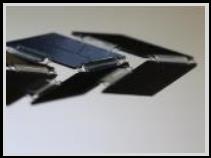
|
CubeSats and Micro Robots |

|
Home | Contact Us | Research | Publications | People |


|
(Left) Origami solar panel, (middle) Concept for micro flapping-wing aerial vehicle, (right) Origami driving.
A CubeSat is a type of miniaturized satellites built with cubes, which has a volume of exactly one liter (10 cm3) and is just like pico satellite. With modern electronics technology, CubeSate provides a low cost, low mass and flexible platform for space missions and becomes one of major mission development directions. However, the small dimension also constrains its performance, for example, limited area for solar power supply and long range RF communication. Meanwhile, the micro flapping-wing aerial vehicle, a bio-inspired insect-type flight, has attracted industry attention, since it can be used for military and intelligence service, and disaster rescuing. One of the bottlenecks for the technology is similar with CubeSats: power and communication. Further, the wings of vehicle are fragile part and occupy too much room. Therefore, We have developed an origami enabled manufacture technology to conquer the challenges. Origami, traditional art of paper folding, has been applied to some engineering applications (e.g. stents and airbags) based on its principle of creating 3D structures from two-dimensional (2D) sheets through a high degree of folding along the creases. One of the special features and advantages of origami, a perfect solution for solar panel and antenna, is to save the storage space while folded, but it can cover big area after unfolding. However, in small or micro scale, people have only explored very simple folding structure with limited materials. There is a need then in the pertinent art by fully employing origami structures to produce wide functionality, reduce the space required, and improve portability and performance in micron to cm scale. In our technology, we use standard manufacturing technology to produce high performance materials, structures, devices, circuits and/or systems on a conventional planar substrate (e.g. silicon wafers). After releasing hinge-type connections, the planar substrate can then be converted into a three-dimensional structure with origami shape by self-assembling and actuation, and/or from external forces working on connections. We have demonstrated miniature origami solar panel and origami lithium ion battery with great performance. The resulting origami 3-D products can provide small projection area (i.e., a more compact product or dense product), high portability, good deformability from folds for solar panel, antenna, thin film type of battery and big format mechanical structure for CubeSats and Flapping-wings.
· Z. Song, T. Ma, R. Tang, Q. Cheng, X. Wang, D. Krishnaraju, R. Panat, C. K. Chan, H. Yu, and H.Jiang, “Origami Lithium-ion Batteries” Nature Communications, Volume: 5 Article Number: 3140 Published: JAN 2014 (pdf) · R. Tang, H. Tu, Y. Xu, H. Jiang and H. Yu, “ Micro Origami Solar Panel” Applied Physics Letters, Volume: 104 Issue: 8 Article Number: 083501 Published: FEB 24 2014 (pdf) · H. Tu, H. Jiang, H. Yu and Y. Xu, “Hybrid silicon-polymer platform for self-locking and self-deploying origami” Applied Physics Letters, Volume: 103 Issue: 24 Article Number: 241902 Published: DEC 9 2013 (pdf) |